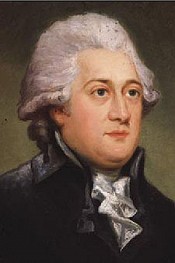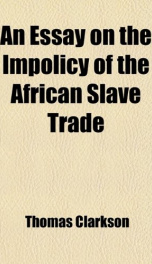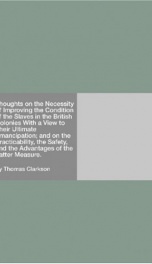Clarkson Thomas

Thomas Clarkson (28 March 1760 – 26 September 1846), abolitionist, was born at Wisbech, Cambridgeshire, England, and became a leading campaigner against the slave trade in the British Empire. He helped found Committee for the Abolition of the Slave Trade and achieve passage of the Slave Trade Act of 1807, which ended British trade in slaves. Clarkson was the son of Rev. John Clarkson (1710–1766). He attended Wisbech Grammar School where his father was headmaster; then he went on to St Paul's School in London in 1775. He did his undergraduate work at St John's College, Cambridge, beginning in 1779.[1] An excellent student, he appears to have enjoyed his time at university, although he was also a serious, devout man. He received his B.A. degree in 1783 and was set to continue at Cambridge to follow in his father’s footsteps and enter the Anglican Church. He was ordained a deacon but never proceeded to priest's orders. It was at Cambridge in 1785 that Clarkson entered a Latin essay competition that was to set him on the course for most of the remainder of his life. The topic of the essay, set by university vice-chancellor Peter Peckard, was Anne liceat invitos in servitutem dare (Is it lawful to enslave the unconsenting?).[2], and it led Clarkson to consider the question of the slave trade. He read everything he could on the subject, including the works of Anthony Benezet, a Quaker abolitionist. Appalled and challenged by what he discovered, Clarkson changed his life. He also researched the topic by meeting and interviewing those who had personal experience of the slave trade and slavery. After winning the prize, Clarkson had what he called a spiritual revelation from God as he travelled on horseback between Cambridge and London. Having broken his journey at Wadesmill, near Ware, Hertfordshire, as he stopped, 'A thought came into my mind', he later wrote, 'that if the contents of the Essay were true, it was time some person should see these calamities to their end' (Clarkson, History, vol. 1). It was this experience and sense of calling that ultimately led him to devote his life to abolishing the slave trade. Having translated the essay into English so that it could gain a wider audience, Clarkson published it in 1786 as "An essay on the slavery and commerce of the human species, particularly the African, translated from a Latin Dissertation", which was honoured with the first prize in the University of Cambridge, for the year 1785.[3] The publication of the essay had an immediate impact, and Clarkson was introduced to many others who were sympathetic to abolition, some of whom had already published and campaigned against slavery. These included influential men such as James Ramsay and Granville Sharp, the Quakers, and other Nonconformists. The movement had been gathering strength for some years, having been founded by Quakers in both Britain and the United States, with support from other Puritans or Nonconformists on both sides of the Atlantic. In 1783 three hundred Quakers, chiefly from the London area, presented the British Parliament with the first petition against the slave trade. Following this step, a small offshoot group sought to form the Committee for the Abolition of the Slave Trade, a small non-denominational group that could lobby more successfully by incorporating Anglican and Parliamentary support (Quakers were disbarred from Parliament until the early nineteenth century, whereas the Anglican Church was given seats in the House of Lords). The twelve founding members included nine Quakers, and three pioneering Anglicans – Granville Sharp, Thomas Clarkson, and William Wilberforce — all evangelical Christians sympathetic to the religious revival that had predominantly nonconformist origins, but which sought wider non-denominational support for a 'Great Awakening' amongst believers. Encouraged by publication of Clarkson’s essay, an informal committee was set up between small groups from the petitioning Quakers, Clarkson and others, with the aim of lobbying Members of Parliament (MPs). This was to lead, in May 1787, to the foundation of the Committee for the Abolition of the Slave Trade. The Committee included Granville Sharp as Chairman and Josiah Wedgwood as well as Clarkson himself. Clarkson also approached the young William Wilberforce, who as an (Evangelical) Anglican and an MP could offer them a link into the British Parliament. Wilberforce was one of very few parliamentarians to have had sympathy with the Quaker petition; he had already put a question about the slave trade before the House of Commons, marking himself out as one of the earliest Anglican abolitionists. Clarkson took a leading part in the affairs of the Committee for the Abolition of the Slave Trade, and was given the responsibility to collect evidence to support the abolition of the slave trade. He faced much opposition from supporters of the trade in some of the cities he visited. The slave traders were an influential group because the trade was a legitimate and lucrative business, generating prosperity for many of the ports. On a visit to Liverpool in 1787, the year the Committee for the Abolition of the Slave Trade was founded, Clarkson was attacked and nearly killed by a gang of sailors paid to assassinate him. He just escaped with his life. That same year, Clarkson published the pamphlet: "A Summary View of the Slave Trade and of the Probable Consequences of Its Abolition". Clarkson was very effective at giving the Committee a high public profile: he spent the next two years traveling around England, promoting the cause and gathering evidence. He interviewed 20,000 sailors during his research. He obtained equipment used on slave-ships, such as iron handcuffs, leg-shackles, and thumb screws; instruments for forcing open slave's jaws; and branding irons. He published engravings of the tools in pamphlets and displayed the instruments at public meetings. Clarkson’s research took him to English ports such as Bristol, where he received much data from the landlord of the Seven Stars pub. (The building still stands in Thomas Lane.) He also traveled to Liverpool and London, collecting vital evidence to support the abolitionist case. One of the first African trading ships which Clarkson visited was The Lively. Although not a slave ship, it carried cargo of high quality that had a powerful impact upon Clarkson. The ship was loaded with beautiful African goods: carved ivory and woven cloth, along with produce such as beeswax, palm oil and peppers. Clarkson could see the craftsmanship and skill required to produce many of the items. The idea that their creators could be enslaved horrified him. Clarkson bought samples from the ship and started a collection to which he added over the years. It included crops, spices and raw materials, along with refined trade goods. Clarkson noticed how pictures and artifacts were able to influence public opinion, more than words alone. He quickly realised that his collection of fine goods could reinforce the message of his anti-slavery lectures. He used the items to demonstrate the skill of Africans and possibilities for an alternative humane trading system. The "box" of his collection became an important part his public meetings, and was an early example of a visual aid. He rode by horseback some 35,000 miles for evidence and checked in with local anti-slave trade societies founded across the country. He enlisted the help of Alexander Falconbridge and James Arnold, two ship’s surgeons whom he met in Liverpool. They had been on many voyages aboard slave ships, and were able to recount their experiences in detail for publication. Clarkson also continued to write against the slave trade. He filled his works with vivid descriptions heard first hand from sailors, surgeons and others who had been involved in the slave traffic. Examples included "An Essay on the Slave Trade", the account of a sailor who had served aboard a slave-ship, which was published in 1789. In 1788 Clarkson published his Essay on the Impolicy of the African Slave Trade (1788), which was printed in large numbers. These works provided a firm basis for William Wilberforce's first abolitionist speech in the House of Commons on 12 May 1789, and its twelve propositions. That same year an autobiographical narrative by an African with direct experience of the slave trade and slavery was published; it was highly influential. Clarkson wrote to the Rev. Mr. Jones at Trinity College, introducing Gustavus Vassa (Olaudah Equiano), the African anti-slavery author, who wished to visit Cambridge. Clarkson asked the Rev. Jones for help in selling Equiano's autobiography. In 1791 Wilberforce introduced the first Bill to abolish the slave trade; it was easily defeated by 163 votes to 88. As Wilberforce continued to bring the issue of the slave trade before Parliament, Clarkson traveled and wrote anti-slavery works. It was the beginning of their protracted parliamentary campaign, during which Wilberforce introduced a motion in favour of abolition almost every year. Clarkson, Wilberforce and the other members of the Committee for the Abolition of the Slave Trade and their supporters, were responsible for generating and sustaining a national movement which mobilised public opinion as never before. Parliament, however, refused to pass the bill. The outbreak of War with France effectively prevented further debate for many years. By 1794, Clarkson's health was failing, as he suffered from exhaustion. He retired from the campaign and spent some time in the Lake District, where he bought an estate at Ullswater, and became a friend of the poet William Wordsworth. In 1796 he married Catherine Buck of Bury St Edmunds, Suffolk; their only child Thomas was born in 1796. They moved back to the south of England for the sake of Catherine’s health, and settled at Bury St Edmunds from 1806 to 1816, after which they lived at Playford Hall, halfway between Ipswich and Woodbridge, Suffolk. When the war with France appeared to be almost over, Clarkson and his allies revived the anti-slave trade campaign in 1804. After ten years, he again got on his horse to travel all over Great Britain and canvass support for the measure. He appeared to have returned with all his old enthusiasm and vigour. He was especially active in persuading MPs to back the parliamentary campaign.
do you like this author?
What readers are saying
What do you think? Write your own comment on this book!
write a commentWhat readers are saying
What do you think? Write your own comment on this author!
write a commentBook list

A Portraiture of Quakerism,Volume 3
Taken from a View of the Education and Discipline,Social Manners,Civil and Political Economy,Religious Principles and Character,of the Society of Friends
Series:
Unknown
Year:
Unknown
Raiting:
4.5/5
Show more
add to favoritesadd In favorites

A Portraiture of Quakerism,Volume 2
Taken from a View of the Education and Discipline,Social Manners,Civil and Political Economy,Religious Principles and Character,of the Society of Friends
Series:
Unknown
Year:
Unknown
Raiting:
3/5
Show more
add to favoritesadd In favorites

A Portraiture of Quakerism,Volume 1
Taken from a View of the Education and Discipline,Social Manners,Civil and Political Economy,Religious Principles and Character,of the Society of Friends
Series:
Unknown
Year:
Unknown
Raiting:
3/5
Show more
add to favoritesadd In favorites
Book list

A Portraiture of Quakerism,Volume 3
Taken from a View of the Education and Discipline,Social Manners,Civil and Political Economy,Religious Principles and Character,of the Society of Friends
Series:
Unknown
Year:
Unknown
Raiting:
4.5/5
Show more
add to favoritesadd In favorites

A Portraiture of Quakerism,Volume 2
Taken from a View of the Education and Discipline,Social Manners,Civil and Political Economy,Religious Principles and Character,of the Society of Friends
Series:
Unknown
Year:
Unknown
Raiting:
3/5
Show more
add to favoritesadd In favorites

A Portraiture of Quakerism,Volume 1
Taken from a View of the Education and Discipline,Social Manners,Civil and Political Economy,Religious Principles and Character,of the Society of Friends
Series:
Unknown
Year:
Unknown
Raiting:
3/5
Show more
add to favoritesadd In favorites

The History of the Rise,Progress and Accomplishment of the Abolition of the African Slave Trade by the British Parliament (1808)Volume II
Series:
Unknown
Year:
Unknown
Raiting:
2.5/5
Show more
add to favoritesadd In favorites

An Essay on the Slavery and Commerce of the Human Species,Particularly the AfricanTranslated from a Latin Dissertation,Which Was Honoured with the First Prize in the University of Cambridge,for the Year 1785,with Additions
Series:
Unknown
Year:
Unknown
Raiting:
3.5/5
Show more
add to favoritesadd In favorites

Thoughts on the Necessity of Improving the Condition of the Slaves in the British Colonies
With a View to Their Ultimate Emancipation; and on the Practicability,the Safety,and the Advantages of the Latter Measure.
Series:
Unknown
Year:
Unknown
Raiting:
3/5
Show more
add to favoritesadd In favorites

condition of the slaves in the british colonies 8 6
Series:
Unknown
Year:
Unknown
Raiting:
5/5
Show more
add to favoritesadd In favorites

abolition of the african slave trade by the british parliament clarkson 8 8
Series:
Unknown
Year:
Unknown
Raiting:
4/5
Show more
add to favoritesadd In favorites

abolition of the african slave trade vol ii 8 7
Series:
Unknown
Year:
Unknown
Raiting:
4/5
Show more
add to favoritesadd In favorites

essay on the slavery and commerce of the human species thomas clarkson 8 1
Series:
Unknown
Year:
Unknown
Raiting:
4/5
Show more
add to favoritesadd In favorites

an essay on the impolicy of the african slave trade
Series:
Unknown
Year:
Unknown
Raiting:
4/5
Purchase of this book includes free trial access to www.million-books.com where you can read more than a million books for free. This is an OCR edition with typos. Excerpt from book: Africans, you will excufe the liberty I have taken, under the circumftance now explained; and I muft intreat you to believe, that no encomium fhould ever have been paid you by me, unlefs I had believed it to have been previoufly earned. I have the Honour to be, Sir, Your fincere, And obedient Servant, THOMAS CLARKSON. PREFACE. chapter{Section 4Preface. IT majr be expefited, that, in offering fo many articles of information to the publick, and filch as will materially affect the policy of the flave trade, fomething fhould be faid of their authenticity, or the affurance the publick may have, that they are true; The productions of Africa are the: firft dbjedTfs of con- fideration in this work. Whatever I have faid relative to the exiftence of thefe, has been cfollefted from textit{livfag evidence, and of the greateft part of them I have now fpecimens textit{in my peffejjlon. The cruelties, practifed by the officers of flave veflels on the perfons of their unfortunate crews, (which textit{is, another object of confideration) has been ftated from various textit{depejitions voluntarily made laft year. I have had alfo textit{ocular demonftration, as far as a fight of their mangled bodies will be admitted as a proof, that fuch cruelties were exercifed upon them; and I have had the fatisfaftion of making fome of the perpetrators textit{acknowledge them, by the payment of a fine. The lofs of feamen, both in the flave trade and other trades, (which is a principal objeft of confideration in this work) is fo exact, that, though it was neceflary to have an account of no lefs textit{thanfevnn or textit{eight thoufand of them to afcertain the fact, yet the name of every individual can be given. The lift of plantations, that have been cited as having fupported themfel...
Show more
add to favoritesadd In favorites

a portraiture of quakerism taken from a view of the education and discipline s
Series:
Unknown
Year:
Unknown
Raiting:
5/5
Show more
add to favoritesadd In favorites

a letter to the clergy of various denominations and to the slave holding plante
Series:
Unknown
Year:
Unknown
Raiting:
5/5
Show more
add to favoritesadd In favorites

Thoughts on the Necessity of Improving the Condition of the Slaves in the British Colonies
Series:
Unknown
Year:
Unknown
Raiting:
3.5/5
Thoughts on the Necessity of Improving the Condition of the Slaves in the British Colonies. With a View to Their Ultimate Emancipation; and on the Practicability, the Safety, and the Advantages of the Latter Measure. please visit www.valdebooks.com for a full list of titles --This text refers to the Kindle Edition edition.
Show more
add to favoritesadd In favorites
What readers are saying
What do you think? Write your own comment on this author!
write a commentif you like Clarkson Thomas try:
readers also enjoyed
What readers are saying
What do you think? Write your own comment on this author!
write a commentGenre
if you like Clarkson Thomas try:
readers also enjoyed
Do you want to read a book that interests you? It’s EASY!
Create an account and send a request for reading to other users on the Webpage of the book!

